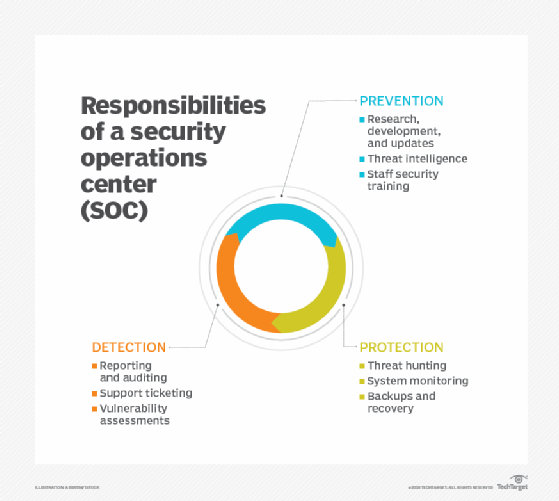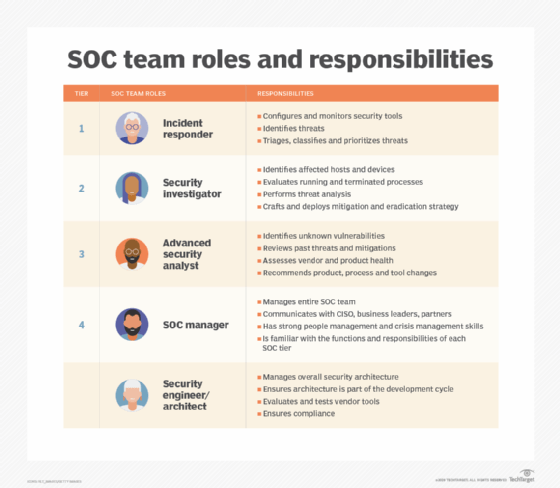What is a security operations center (SOC)?
A security operations center (SOC) is a command center facility in which a team of information technology (IT) professionals with expertise in information security (infosec) monitors, analyzes and protects an organization from cyberattacks.
In the SOC, internet traffic, networks, desktops, servers, endpoint devices, databases, applications and other systems are continuously monitored and analyzed for signs of a potential or actual security incident. SOC staff can work with other teams and departments but are typically self-contained with employees who have high-level IT and cybersecurity skills. Most SOCs function nonstop, with employees working in shifts using security tools to log activity, analyze anomalies, and mitigate and eliminate cyberthreats and malware.
SOCs are an integral part of an organization's data protection strategy, minimizing the costs of a potential data breach. They help organizations quickly respond to intrusions, while improving detection and prevention processes.
Most large organizations have an in-house SOC in the IT department or the network operations center (NOC). Companies without staff or resources to maintain a SOC might outsource some or all SOC functions to a managed service provider or a cloud vendor that offers a hosted virtual SOC.
What does a security operations center do?
SOCs mainly focus on threat detection, assessment and management. They collect and analyze data, looking for suspicious activity. The goal is to make the entire organization more secure.
SOC teams monitor raw security data collected from firewalls, threat intelligence, intrusion prevention and detection systems, probes, and security information and event management (SIEM) systems. Alerts notify team members if data is abnormal or displays indicators of compromise.
The following are the basic responsibilities of a SOC team:
- Asset discovery and management. This involves obtaining a high awareness of all tools, software, hardware and technologies the organization uses to ensure all assets work correctly and are regularly patched and updated. SOC teams must also stay up to date on current cybersecurity technologies, attack signatures and other relevant data.
- Continuous behavioral monitoring. This requires examining all systems on a 24/7 basis. It lets SOCs place equal weight on reactive and proactive measures, so any irregularity is detected quickly. Behavioral models train data collection systems on suspicious activities and are used to preclude false positives.
- Activity logs. These records are used to log all communications and activity across an organization. SOC teams use them to identify previous actions and situations that might have facilitated a breach.
- Alert severity ranking. By ranking the severity of alerts, SOC teams can prioritize them based on occurrence probability and potential damages. This assists with triage efforts when incidents occur.
- Defense development and evolution. This requires teams to stay updated on potential threats and strategies. It includes creating an incident response plan to defend systems against new or ongoing attacks. Teams might need to adjust their plan when new information emerges.
- Incident recovery. Incident recovery includes reconfiguring, updating, and backing up systems and mission-critical data.
- Testing and exercising cybersecurity measures. SOC teams test and ensure that all cybersecurity resources are appropriate for the job. This also requires that cyberteam members know their roles and responsibilities in a breach situation.
- Security infrastructure maintenance. SOC teams deploy, configure and maintain security tools to manage and maintain the security infrastructure. They also ensure that these tools are integrated into the development lifecycle.
- Compliance management. SOC teams ensure adherence to regulatory and cybersecurity standards in carrying out cybersecurity activities. Typically, one team member oversees compliance duties.
- Documentation and reporting of cyberevents. Thorough documentation and reports on cyberevents are essential for SOC teams to facilitate reviews, training and audits.
- Evidence gathering for IT audits. Gathering evidence for IT audits is important and requires having a principal repository of data relating to cyberactivities, cyberattacks and post-event reporting.
Other SOC capabilities include reverse-engineering, forensic analysis, network telemetry and cryptanalysis based on the organization's specific needs.

Who needs a security operations center?
SOCs are commonly found in healthcare, education, banking and finance, insurance, e-commerce, government, military operations and advanced technology industries.
Before establishing a SOC, an organization must align its security strategy with current business goals and programs. The SOC aims to protect an organization's security posture by establishing systems to identify potential and real-time security threats.
When determining the need for a SOC, senior leadership might examine data from periodic risk assessments and other reports that focus on core needs, such as the following:
- Identifying requirements to maintain the company's mission if a cyberattack occurs.
- Defining policies and procedures for managing cybersecurity operations and remediating cyberattacks if they occur.
- Establishing an incident response process for handling a cyberevent.
- Evaluating existing security measures to identify gaps and areas needing improvement.
- Documenting the infrastructure resources, systems and management tools needed to respond to a cyberattack.
- Identifying and training security teams responsible for identifying and responding to cyberevents.
- Establishing a formal cybersecurity function with security professionals to prepare for and manage attacks via a SOC.
Building a winning SOC team
SOCs are staffed with a diverse set of individuals who play a role in managing security operations. Job titles and responsibilities found in a SOC include the following:
- Chief information security officer. The CISO is a high-ranking executive who oversees the development and execution of the organization's cybersecurity strategy. Their role involves aligning security efforts with business goals, ensuring compliance with regulations, managing long-term risks and defining security policies.
- SOC manager. This person directs the SOC's daily operations and its cybersecurity team. They also provide updates to the organization's executive staff.
- Incident responder. An incident responder handles successful attacks and breaches, doing what's necessary to mitigate and remove the threat.
- Forensic investigator. This is the individual or group that identifies the root cause of an issue, locates the attack source and collects supporting evidence.
- Compliance analyst. This person ensures all SOC processes and employee actions meet compliance requirements.
- SOC security analyst. This is who reviews and organizes security alerts based on urgency and severity. They also run regular vulnerability assessments. SOC analysts have skills such as knowledge of programming languages, cybersecurity systems, ransomware systems, administrative capabilities and security practices.
- Threat hunter. Also known as a threat analyst, this person reviews data the SOC collects to identify hard-to-detect threats. Resilience and penetration testing might be part of a threat hunting routine.
- Security engineer/architect. This staffer develops and designs the systems and tools essential for effective intrusion detection and prevention, vulnerability assessments and event response management.
- SIEM engineer. This engineer manages and optimizes systems to ensure proper logging, alerting and correlation with security events.

Types of security operations centers
An organization establishing a SOC can choose from several models, including the following:
- Dedicated or self-managed SOC. This model has an on-premises facility with in-house staff.
- Distributed SOC. This model is also known as a co-managed SOC. It has full- or part-time team members hired in-house to work alongside a third-party managed security service provider (MSSP).
- Managed SOC. This model has MSSPs providing all SOC services. Managed detection and response partners are another type of managed SOC.
- Command SOC. This model provides threat intelligence insights and security expertise to other, typically dedicated, SOCs. A command SOC isn't involved in security operations or processes, just intelligence.
- Fusion center. This model oversees any security-focused facility or initiative, including other types of SOCs and IT departments. Fusion centers are considered advanced SOCs and work with other enterprise teams, such as IT operations, DevOps and product development.
- Multifunction SOC. This model has a dedicated facility and in-house staff, but its roles and responsibilities extend to other critical areas of IT management, such as NOCs.
- Virtual SOC. This model lacks a dedicated on-premises facility and can be enterprise-run or fully managed. An enterprise-run SOC is generally staffed by in-house employees or a mix of in-house, on-demand and cloud-provided employees. A fully managed virtual SOC, also known as an outsourced SOC or SOC as a service (SOCaaS), has no in-house staff.
- SOCaaS. This subscription-based or software-based model outsources some or all SOC functions to a cloud provider.
- Global security operations center. A GSOC is a centralized hub that coordinates security efforts across all organizational locations. For multinational companies, a GSOC provides a comprehensive view of security throughout the organization. By centralizing security operations, a GSOC eliminates the duplication of efforts across different locations, resulting in more efficient processes and reducing the need for multiple infrastructures.
Security operations center best practices
There are several best practices for running a SOC. Success starts with selecting the optimal model for an organization, staffing the team with the best security specialists, and adopting the proper tools and technologies.
Next, establish policies and procedures for the SOC, ensuring they have senior management approval and comply with the organization's standards and regulations. The SOC might provide important data needed when evaluating cybersecurity insurance.
Organizations should establish security orchestration, automation and response (SOAR) processes whenever possible. Combining the productivity of an automation tool with the technical skills of an analyst helps improve efficiency and turnaround times. It also maintains the SOC function without interruption.
SOCs rely heavily on the knowledge of cybersecurity team members. Managers should provide ongoing training to stay on top of emerging threats, cybersecurity incident reports and vulnerabilities. SOC monitoring tools should be updated and patched regularly to reflect any changes.
A SOC is only as effective as its strategies. Managers should set up operational protocols, specified in SOC policies. These should be strong enough to ensure a consistent, fast and effective response.
Other SOC best practices include the following:
- Periodically testing systems and incident response activities.
- Obtaining security risk visibility across the business.
- Collecting as much relevant data as possible as often as possible.
- Taking advantage of data analytics.
- Developing scalable processes.
AI and machine learning are increasingly part of cybersecurity management systems. Adoption of AI functionality in a SOC is likely to improve its ability to identify potential attackers and defeat them before they can strike.
Network operations center vs. security operations center
A NOC is similar to a SOC in that its basic responsibilities are to identify, investigate, rank and fix issues. A NOC manager or team lead oversees all employees and processes in the center. Most of the staff members are network and traffic engineers, some of whom might have more specialized or technical backgrounds to cover a diverse range of incidents.
Unlike in a SOC, a NOC team primarily handles issues related to network performance, reliability and availability. This includes implementing processes for network monitoring, device malfunctions and network configuration. A NOC is also in charge of ensuring the network meets service-level-agreement requirements, such as minimum downtime and network latency.
SOCs and NOCs respond to different types of incidents. Network issues are typically operational events, such as a switching system malfunction, traffic congestion and a loss of transmission facilities.
By contrast, cybersecurity events come from sources both inside and outside the organization's control. They use existing networks to gain unauthorized access to company resources. They can also involve social engineering attacks, using coercion or tricks to get people to share confidential information. Rogue employees, who present a serious security risk, especially if they know security access codes, are also under the SOC's purview.
NOCs typically cover hardware and physical equipment repairs, software management, and coordination with network carriers, internet service providers and utility companies.
NOCs are useful for organizations that rely on website accessibility and reliable internet connections, such as e-commerce businesses. As such, it can be advantageous to colocate a SOC with a NOC.
Different SOC tiers
Security operation centers are typically structured into three tiers based on the complexity and severity of the cybersecurity events dealt with. The following is a breakdown of the tiers.
Tier 1
Tier 1 analysts are the first line of defense in a SOC. They monitor security alerts, prioritize them and perform initial investigations. These analysts typically handle the following basic tasks:
- Monitor security dashboards and SIEM systems.
- Analyze and filter security logs.
- Identify and classify security alerts.
- Follow established incident response playbooks for known issues.
- Escalate complex or suspicious incidents to Tier 2.
The primary focus of Tier 1 SOC analysts is to filter out false positives and manage routine security events. Analysts in this tier generally have a fundamental understanding of cybersecurity tools and processes, strong attention to detail and the ability to adhere to established runbooks.
Tier 2
Tier 2 analysts are security engineers with more advanced technical skills and experience. They handle complex investigations and incident response tasks, such as the following:
- In-depth analysis of security incidents.
- Forensic analysis of systems and data.
- Threat hunting and proactive security monitoring.
- Development and execution of containment and remediation strategies.
- Technical support to Tier 1 analysts.
Tier 2 engineers concentrate on in-depth analysis, threat mitigation and remediation. They have advanced knowledge of cybersecurity tools, experience with threat hunting and the ability to analyze complex data sets.
Tier 3
Tier 3 analysts are the most experienced members of the SOC. They focus on proactive threat hunting, advanced incident response and development of strategies to enhance their organization's security posture. Their typical duties include the following:
- Advanced threat hunting and proactive security research.
- Reverse-engineering malware.
- Development and execution of security tools and techniques.
- Expert guidance on complex security incidents.
- Security architecture review.
- Advanced forensic investigations.
Experienced Tier 3 SOC personnel are responsible for avoiding emerging threats and developing advanced security capabilities.
In some organizations, Tier 4 positions are designated for SOC managers who oversee the entire SOC. These individuals play an essential role in shaping the direction of the SOC and are tasked with responsibilities such as recruiting talented personnel, developing strategic initiatives and providing reports to upper management regarding the operation's performance and effectiveness.
SOC tools
SOCs rely on various tools to monitor, detect, analyze and respond to security threats effectively. According to independent research from Informa TechTarget and Gartner reviews, here are some key categories and examples of SOC tools:
- Endpoint detection and response. EDR tools monitor and respond to suspicious activities on endpoints, such as laptops, servers and mobile devices. They are essential for detecting sophisticated attacks that might bypass traditional network defenses, enabling rapid response to threats at the endpoint level. CrowdStrike Falcon, Microsoft Defender for Endpoint and SentinelOne Singularity Platform are examples of EDR and extended detection and response tools.
- Intrusion detection. These systems monitor network traffic for suspicious activity, alerting organizations to potential security violations. Examples include Cisco Secure Firewall, Trellix Intrusion Prevention System and Trend Micro TippingPoint.
- SIEM. These tools are crucial in collecting and analyzing security data across an organization's IT infrastructure. These tools are indispensable for threat detection and response, providing real-time monitoring and alerts for potential security incidents. They correlate events from multiple sources, empowering SOC teams to discern patterns that could signify security breaches. IBM Security QRadar SIEM, Splunk Enterprise and Trellix Enterprise Security Manager are some examples of SIEM tools.
- SOAR. SOAR tools streamline incident response processes by automating repetitive tasks, orchestrating workflows and accelerating response times. They work with existing security options to improve efficiency and effectiveness. Notable examples of SOAR platforms are FortiSOAR, Google Security Operations, KnowBe4 PhishER Plus and Swimlane Turbine.
- User and entity behavior analytics. These tools focus on detecting deviations from regular user and entity behavior, identifying anomalies that might indicate malicious activity. Examples of user and entity behavior analytics tools include Proofpoint Insider Threat Management, Securonix User and Entity Behavior Analytics, and Varonis Data Security Platform.
- Vulnerability management. These tools help organizations identify and assess vulnerabilities in their systems and applications, enabling them to prioritize remediation efforts and reduce their risk exposure. Examples of vulnerability management tools include Rapid7 InsightVM, Qualys Vulnerability Management Detection and Response, and Tenable Nessus.
Find out more about how generative AI is being used in security operations and how this might affect security operations centers.







